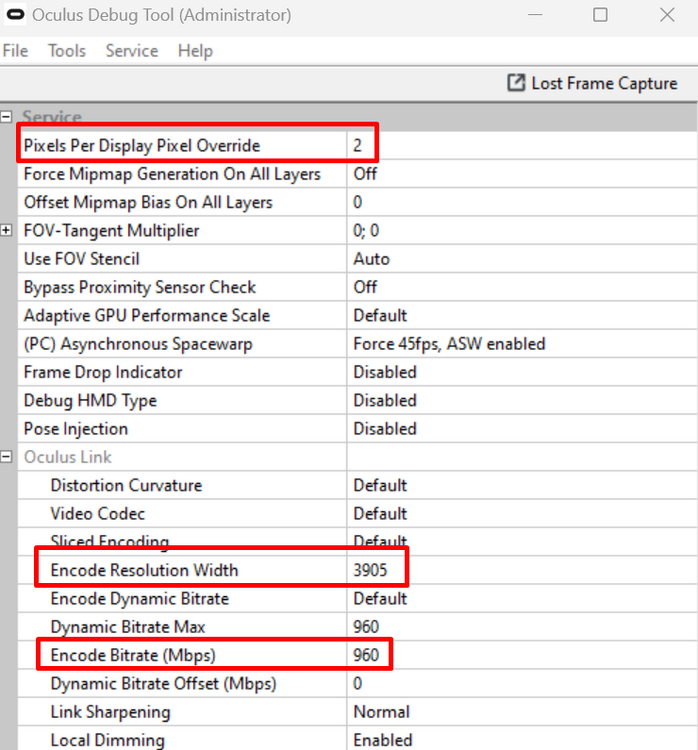-
Posts
375 -
Joined
-
Last visited
Content Type
Profiles
Forums
Events
Everything posted by gonvise
-
Hi, you're right about that the disable auto updates switches inside helmet only applies to the apps and games that get installed in the headset. But I don't know what you mean by renaming the directories, I have the SO updates disabled via Sidequest -> File explorer+ -> Oculus OS Updated Disable. It works because when I go to the updates screen the icon searching for updates appears indefinitely.
-
Correct, going directly to WP 13 triggers the second message, I thought it was better to go through the entire route as you say in the general instructions, but the message is clear, my fault.
-
v67 without problem, with toolkit eye tracking and last DCS update the best experience for me until now.
-
Disabling Quest pro automatic updates in 3-2-1...
-
No, twice no, only one... after first push back, message say me RTB via WP 13... I'm going to try again... after the first push back, I must go WP 13 directly or passing through all route WP's until 13? At no time during the rest of the route through these points was I told that the F5s had crossed again.
-
After escorting the Turkish F5s out of the airspace, validated with a message saying that the F5s have left and RTB via WP 13, when passing said WP 13 I get a message saying that the mission failed because I have not managed to drive the F5s away.
-
I used to have the same audio stutters problem with that bitrate, but it was fixed starting with v62. Now I don't have any audio stutters. Considering I have a 10900K (worse than yours) and a 4090 (same), give it a try No, I think it's just me . I've tried with and without local dimming, enabling and disabling it from both the experimental menu and the OTT, and testing the F18 Carrier Case III's night mission, but I can't tell the difference. However, I put ASW fluidity and link cable scaling first, I've tried the VD's local dimming and I wouldn't change the other things to have local dimming, although maybe it's because I have the gamma at 1.7, otherwise the nights would seem like a party I agree that with each update of [x], where x is [quest pro, quest app, DCS], we may stop having one thing or another, but in the case of v68, the first thing is that it is PTC, we will see when the stable version comes out, and according to what I have read in several posts, what stops working is mbucchia's toolkit, not QVFR. On the other hand, I think I read in this same thread that mbucchia himself answers that VD has problems implementing QVFR and currently they do not know if they will be able to or not. And as for the difference between ASW and SSW, please tell me what to do! with ASW and 45FPS relaxed, the head turn is a delight, practically like in real life, totally fluid, but with the same conditions in VD with SSW, in said turns the sky/terrain jumps more than a frog
-
If "godlike" is not enough and you want more quality, it would be a matter of increasing the DCS PD or the central part multiplier of QVFR. But in my opinion, the problem with this is that in the end you are burdened by the 150Mbs of Hvec-10, or if you put h264+ then 400Mbs, but it is still far from the 900Mbs that you can put via cable link. In short, I think that no matter how much you increase the scaling from the "god like" via DCS PD or QVFR, the encoding bitrate will not allow you to perceive the improvement in clarity as you should. I insist, the quest pro "shine" with a 2.0 scaling, encode resolution 3905 and encode bitrate 960 via cable link (OTT), so the first thing I would do is test this to have a reference, then each one has his own eyes and expectations
-
Do you have to enable the option of send eye tracking data in VD streaming settings in-VR. For me, QVFR works the same via VD than link.
-
Regarding VD local dimming, it is better than the one activated in the quest pro? Because despite what you say, the one activated in the developer options of the quest pro works for me in DCS. The blacks when loading are "almost" black, and the cursor does not shine like before v51, which is when they added local dimming. The night missions aren't perfect, but much better than with local dimming option disabled. Or I am missing something (which could be the case), because as I said, I have never stopped "noticing" that I have local dimming in DCS, or you have not tried the local dimming that is in the developer options. Could it be?
-
In my case, I haven't noticed a difference in the speed of eye tracking with link or with VD. However, I recommend that you try the foveated rendering of the toolkit; as mbucchia said, it is a different method and in principle it gives less performance gain than the QVFR, but it works better for me since it demands less CPU. Honestly, I have always believed that local dimming worked by enabling it only in the developer options, but it seems that according to what you say it doesn't work with link. Even so, I haven't noticed a difference either, perhaps because my tests have only been during the day.
-
After trying DCS with virtual desktop, with a dedicated wifi 6e router, I have not managed to reach either the graphic quality or the fluidity that it gives me through cable link, and although I love the virtual desktop compared to the quest app, once inside DCS there is no comparison. Scaling to 2.0 via OTT gives a quality clearly superior than "godlike" of VD. I have tried to use the QVFR scaling, putting it at 2.0, but even so the clarity is below that with OTT 2.0. Maybe it is due to the video compression, which using the h264+ codec is a maximum of 400Mbs, but through cable I have it at 900Mbs (via OTT), and I notice the blurry vision of said compression comapared to 900Mbs. Finally, as you say, SSW is not as good as ASW... not even close. For all this, taking into account that the 4090 can handle via cable link scaling to 2.0, transmission at 900Mbs, and my goal is always to maintain 45FPS in all situations so that the ASW does its magic (at the cost of a little ghosting only in airplanes), for me the cable link is unbeatable at the moment. Even if you don't have the equipment for adequate performace, you can try to put (via cable link and OTT) scaling 2.0, encode bitrate 960Mbs, enconde resolution 3905 and ASW if you've never done it before and you'll see the "clarity" I'm talking about. Don't get me wrong, since I first tried Virtual Desktop it has improved a lot, but taking into account that many of you prefer the VD (wifi) instead of the link cable, I don't know if I'm missing something or doing something wrong...
-
Taking advantage of the post and that I have bought a wifi 6e router, I would like to try the quest pro with Virtual Desktop, due to the good the things you have mentioned about it, but I would like to know before if I will be able to use, as I do via cable link, everything the next: 90 HZ Scaling = 2.0 ASW = 45 bitrate = 900Mb mbucchia's toolkit and QVFR ... can you really achieve the same clarity and fluidity via WiFi as with these settings with pc link?
-

Mission 1 GBU's don't explode?
gonvise replied to gonvise's topic in F/A-18C Operation Green Line Campaign
Ok, thanks, tested again and works. Great first misión! -
Hello, it's probably my mistake, but in mission 1 neither of the two GBUs explode. Laser code 1688, switch ARM on, I'm not using LST, I simply point my TGP at the target in point track mode, tell Matrix to laser on, and launch them as usual. Perhaps I must to track the Matrix laser via LST before launch? Problem with new fuse logic?
-

Changing 10900K by 7800x3D worth It?
gonvise replied to gonvise's topic in PC Hardware and Related Software
Thanks for all the answers. Currently I have the 10900 at 5Ghz. I was pretty happy with my setup, but since the last DCS update the mbucchia XR toolkit's foveated rendering has been starting to work (eye tracking), and it's given me the best VR experience I can remember in DCS, with virtually no stutters even in missions with a lot of objects. But taking into account that mbucchia no longer supports toolkit, I'm now trying to improve the hardware to try to regain that performance without the use of the XR Toolkit. As for increasing the memory to 64, I think it would be a waste of money since the issue is whether I buy the 7800x3D now or wait for the Zen 5. -
Hello, I am thinking of changing my 10900K for a 7800x3D, and I wanted to ask if the change is worth it and will I notice an improvement in performance. I currently have 32GB, Nvidia 4090, quest pro at 45FPS with ASW and scaling 2. With this scaling the quest pro shine and my team reaches those 45 FPS on most occasions but, for example, in missions with many objects and on the ground stutters are noticeable, and DCS shows CPU BOUND. I would also consider increasing the RAM to 64, but I don't know if it's really worth it.
-
Without modifying the loadout, they simply do not explode, I suppose because of the fuze update. By modifying the loadout and re-setting the fuze, they explode, I am sure I hit the correct buildings, I visually confirm that they explode and collapse, but the message on each of the targets is that I have failed.
-
Probably caused by bomb fuze update. Solved editing fuzing options before the mission.
-
After the message to start searching the convoy area, they never spawn.
-
@mbucchia, impose upon your time once again, could you briefly try to explain to me why with the eye tracking of the toolkit my performance is clearly superior compared to QVFR, with much fewer stutters and stability, especially noticeable in very populated areas such as airfields and cities? I still don't understand why this has been able to work after the last DCS update, but it is so far my best experience in terms of fluidity... Tested on a computer with 10900K, 4090, Quest Pro, 45 AWS. Toolkit with eye track config: QVFR config: Thanks again and again!
-
@mbucchia, when arrive the long awaited correct FOV submission (Thanks ED), and taking into account that you made a work-around to "bypass" this ED's bug in your QVFR... it will it still work or will it need some adjustment?
-
@LePaul, in this momment there are two options: 1. Try mbucchias's VRS Foveated Rendering (OpenXR Toolkit Eye Tracking) that works since last update 2. Try the not official and not fix which re-enables QVFR in DCS but probably breaks any other VR game you have (search in this post).






